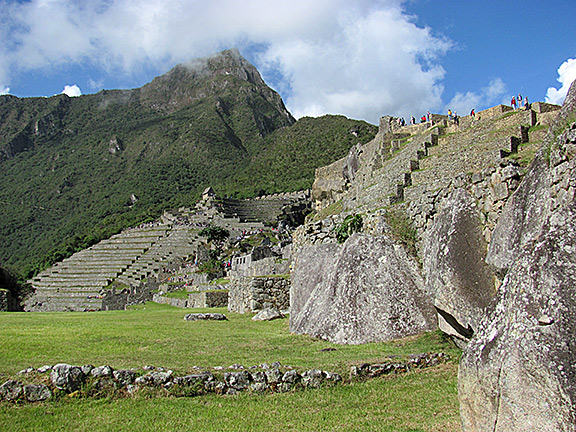
Looking up at Machu Picchu Montaña from the ruins
“The Incas were about my height,” panted my five-foot, two-inch cousin as we climbed the ancient stone steps above Peru’s famed Machu Picchu. “Why did they build such tall steps?!”
Indeed, we both were struggling with the 10- to 12-inch-high steps that led up Machu Picchu Montaña, the big mountain rising 1,640 feet above “the lost city of the Incas.” The city’s stunning ruins perch on a saddle between two sacred peaks: Huayna Picchu (“young mountain” in the native Quechua language), famously pictured in postcards behind the ruins, and Machu Picchu Montaña (“old mountain”). On both sides of the saddle are sheer drops to the Urubamba River snaking its way through the valleys far below.
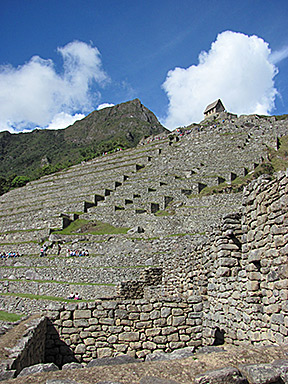 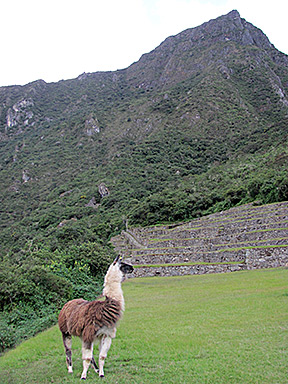
Machu Picchu Montaña with terraces and a llama below
My cousin and I had already explored Machu Picchu’s ruined temples, plazas, dwellings and agricultural terraces early that morning. Unlike most of our group, we opted for tickets to climb Machu Picchu Montaña rather than Huayna Picchu – so popular that only 400 visitors per day are now allowed to climb it. There were no such restrictions on the Montaña trail because it was recently opened and is relatively unknown.
Since July 2011, Machu Picchu has been protected by tough entrance rules to reduce the impact of tourism on this UNESCO World Heritage Site. Only 2,500 visitors per day are allowed to enter, making advance ticket purchase a necessity, especially during the peak tourist season of late May to early September.
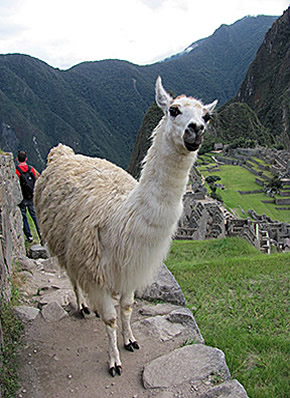 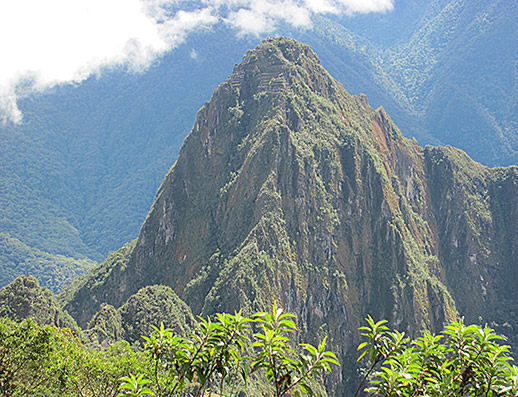 Up maybe too close llama Starting-hike-view-across-to-Huayna-Picchu Up maybe too close llama Starting-hike-view-across-to-Huayna-Picchu
One can buy a ticket just to the ruins or add on the Huayna or Montaña trails for additional cost. Climbing either trail must be done during specified times.
So just before the 11 AM deadline to gain entrance, we found the trailhead by the agricultural terraces, where our tickets were duly checked. Then we started climbing the seemingly endless stone steps up Machu Picchu Montaña. The ticket advised approximately one hour 40 minutes to the summit. It took us two hours and 15 minutes.
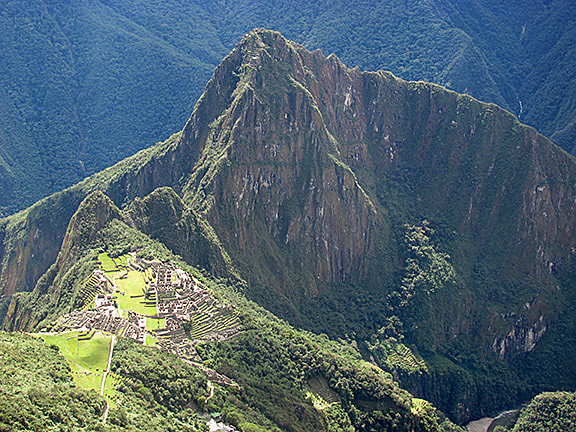
Montana Picchu hike with view of the ruins and Huayna Picchu
Granted, the altitude slowed us down. We’d been in the tourism hub of Cuzco (11,200 feet high) and town of Urubamba (9,420 feet) for a few days before going to Machu Picchu – which is actually lower at 7,970 feet. But that’s still way above sea level for coastal dwellers like us; we were definitely not acclimated to this kind of altitude. Plus the Montaña peak rises up 1,640 feet above Machu Picchu – more than twice as high as Huayna Picchu. At the summit, we were over 9,600 feet.
The hike was well worth the frequent stops to catch our breath and rest aching leg muscles. We ascended from lush, semi-tropical forest into sparser vegetation that afforded exhilarating views of Machu Picchu and the river valleys below. The higher we climbed, the more spectacular the vistas we enjoyed.
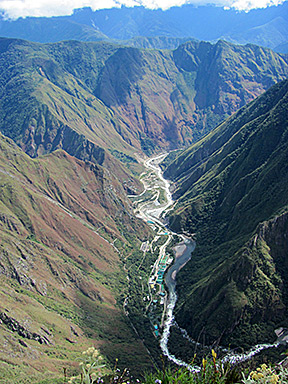
Urubamba River Valley from the top
We had the trail practically to ourselves. Earlier, Huayna Picchu’s steep trail had looked like a solid line of ant-people creeping upwards in lockstep. In contrast, we met few other hikers going up or down Montaña, and encountered less than a dozen folks savoring the view at the summit. Perhaps because there were so few people on the trail, birds and butterflies fluttered the entire way around us.
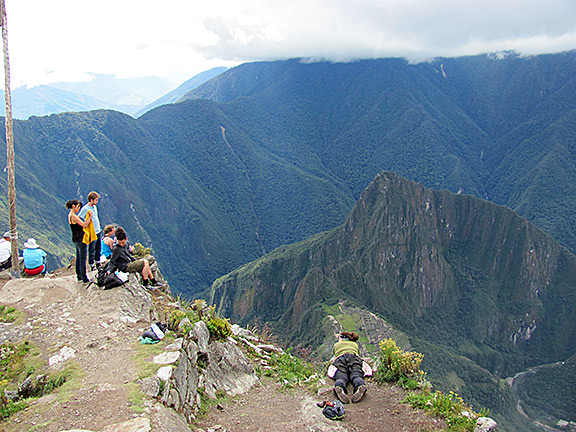
The view from the top of Machu Picchu Montaña
From the top, we had a bird’s eye view of Machu Picchu, now far below. Huayna Picchu appeared quite different when we could see its large “shoulders” not visible from the ruins. The surrounding peaks of the Andes accentuated Machu Picchu’s amazing perch on the ridge saddle between Huayna and Montaña. We could begin to understand why the ancient Incas build their citadel in its impossible location – for the sweeping vistas, as well as for security, if nothing else.
Walking down all those Inca steps challenged our legs as well. But we didn’t have to stop to catch our breath as often and descended in just 1½ hours. Perfect timing to return to Machu Picchu. By 3 PM all the big tour groups had departed, leaving the citadel relatively uncrowded. We relished exploring further in the now quiet ruins as the resident llamas grazed and posed for photos as if on cue. The guards shooed us – and the llamas – out just before the last bus departed at 5:30 PM.
-and-cousin-Barbara-at-summit_of_machu_picchu_montana.jpg)
Author Julie Gangler and her cousin Barbara at the summit
Background:
Machu Picchu is one of South America’s most visited destinations – and Peru’s major tourism attraction. Archaeologists believe it was built as an estate/retreat for the ninth Inca emperor, Pachacútec (1438–1472), although they differ on whether it also served as a religious or astrological site.
Machu Picchu is astonishingly well preserved because the Spanish never discovered it during their ruthless conquest of Peru in the 1500s. However, the Incas apparently abandoned the city, and it was only rediscovered in 1911 by Hiram Bingham III, then a history lecturer at Yale University. Bingham coined the term "lost city of the Incas,” believing Machu Picchu to be Vilcabamba, the Incas’ last refuge from the Spanish conquistadors. This was later disproved, but the phrase stuck.
Getting there:
Take the train from Cuzco (four hours) or Ollaytatambo in the Sacred Valley (two hours) to Aguas Calientes. From this tourist-oriented town, shuttle buses zigzag 2,000 feet up the mountainside to Machu Picchu and back. Spend two nights in Aguas Calientes to have a full day at Machu Picchu. Take an early bus up, see the ruins, do the Montaña hike and enjoy the afternoon in this amazing archeological site minus the group tours.
Tickets:
Purchase tickets in advance, especially April–October. The official website is http://www.machupicchu.gob.pe/ (If you would like to read this in English, click on the British flag at the top right of the home page.)
You can also purchase tickets at the offices of the Ministerio de Cultura, Dirección Regional de Cultura Cusco.
Cuzco office: Avenida la Cultura, Nº 238 Condomio Huáscar
Aguas Calientes office: Avenida Pachacutec (no street number, just off the main plaza)
Choose the MACHUPICCHU-MONTAÑA ticket for a specific day. Currently it costs S/142 (Peruvian nuevo sol) or about $51 USD for a foreign adult. You must begin the Montaña hike between 7 and 11 AM.
|